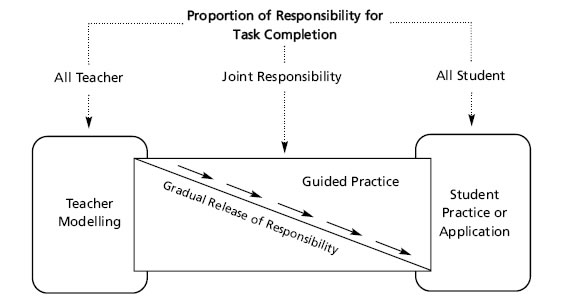

Horizontal Axis - Four Columns
The horizontal axis of the Literacy with ICT Developmental Continuum is composed of four columns that break down each Big Idea as a developmental sequence that follow Pearson and Gallagher's “Gradual Release of Responsibility” Model of Explicit Instruction.

(Manitoba Education and Early Childhood Learning, Independent Together, 2003)
A simpler representation of this model can be seen as follows:

Column 1: I Do, You Watch (Modelling)
The descriptors listed in the first column of the continuum, describe skills and knowledge about which learners already have some prior understanding, or that they acquire as the result of direct instruction and teacher modelling. Descriptors in this column typically state and underline teacher guidance and modelling; for example, “constructs questions with assistance”, “follows a given plan”, “gathers information from given sources”. There is an expectation that teachers will guide students, that there will be much collaborative work as students learn from one another, and that teachers will model and students will follow directions.Teachers model learning behaviours such as building criteria, self-assessment, seeking feedback, making adjustments, goal setting, and reflection.
Column 2 and Column 3: I /We Do, You Help (Sharing) and You Practice, I help (Guiding)
The descriptors in the second and third columns describe the thinking skills and knowledge learners apply, with teacher support, to new learning and experiences. In these two columns of the continuum, students learn to take their learning into their own hands, with the guidance of the teacher. While there is still modeling happening, students are expected to draw upon their own experiences and to extend their learning into new areas. There is a constant exchange of responsibility between teacher and student. Under this gentle release, students are still nurtured yet learn to learn independently.
Column 4: You Do, I Watch (Independent)
The descriptors in the fourth column of the continuum describe more complex thinking behaviours, such as synthesis and evaluation, in which learners engage to create products and representations with increasing independence. This involves synthesizing, transforming, and evaluating knowledge. Learners employ the higher-level critical and creative thinking skills, which they have begun to develop previously, to complete and evaluate authentic learning tasks employing ICT. Learners produce more complex representations by combining and transforming the prior understandings they have constructed, through asking essential questions, solving problems, and creating original representations that express ideas, feelings, and understandings for specific audiences.
The fourth column of the continuum describes students taking charge of his/her learning. The teacher takes a “guide on the side” role as students strive to become independent learners. This does not mean that students are expected to work on their own, but rather that they have a measure of control over their learning, be it on their own or within a group.